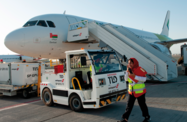Oman is pushing ahead with plans to deploy a nation-wide rail network, with this excepted to boost the economy by expanding logistics capacity and linking up the Sultanate’s ports and production centres.
On January 31, Salim bin Mohammed Al Affani, director-general for physical planning at the Supreme Committee for Town Planning (SCTP) – the state body charged with overseeing the development – told local media that contracts for route design and project management would be awarded by June, with the first services scheduled to begin operations within six years.
“A tender document for pre-qualified firms will be issued soon,” he said. “It will take two years for the consultants to design the railway route and another four years to complete construction work.” Although Al Affani expects operations on the Sohar-Muscat route to begin by 2017, it will “take more time to complete” the remainder of the 1500-km network.
While fast-moving passenger trains – with speeds up to 350 km per hour (kmph) – are likely to catch the public eye, it is the freight component of the planned rail system that is expected to be particularly important for the Omani economy – not to mention profitable.
Under the broad criteria set out by SCTP, freight trains will be required to haul loads of some 10,000 tonnes at speeds of between 80 and 120 kmph. Officials project that the railroad, once fully operational, will carry approximately 11m tonnes of freight between Sohar and the UAE, while lines connecting Muscat with Duqm and Salalah together will account for about 7m tonnes. At least six major freight yards have been proposed at strategic points along the network, with cargo-handling facilities to be established at Sohar, Barka, Al Misfah, Ibra, Sinaw and Buraimi.
Given the country’s increasing industrialisation, coupled with the rapid growth of the mining sector, the transport of heavy cargo is becoming more crucial to the expansion of the economy. Of course, for the Omani rail network to reach its full potential, the country’s neighbours will need to keep their own railway projects – interlinking parts of the wider GCC rail network – moving ahead as well.
The planned link between Oman and the UAE is expected to be operational by around 2017, with the lines there part of the region-wide network. When the project is completed, the bloc’s six member states – Kuwait, Oman, the UAE, Saudi Arabia, Qatar and Bahrain – will be connected by a railway stretching more than 2100 km.
However, it is uncertain whether the connection to the UAE will be completed by 2017. Media reports in early 2010 said that preliminary contracts for the project would be awarded within 12 months, but it was not until December that the deadline was set for the network’s initial operations.
In addition, Oman could be at odds with its GCC partners over its preference for electric-powered trains – a choice based in large measure on environmental concerns – rather than diesel as proposed by the other five Gulf countries. Changing from one type of engine to another when crossing Oman’s national borders would add to travel time and reduce the overall compatibility of the regional network.
With the decision to have the entire network electrified, Oman will also have to make further investments in its power generation capacity to maintain the current needed to drive the system, although an expansion of the electricity grid and power stations is already under way.
Located at the entrance to the Gulf with access to the Arabian Sea and the Gulf of Oman, the Sultanate is well placed to serve as a trans-shipment and logistics base for the region. Moreover, as any rail link to the UAE and beyond would bypass the narrow Strait of Hormuz, this land-based option would also offer a secure alternative route for exports.
An efficient rail network could well become a highly profitable operation, with particular benefits for the transport sector. If the broader GCC network is realised according to plan and the links are utilised to their full extent, Oman’s planned railway should help to boost the economy while strengthening the country’s logistics capabilities.

